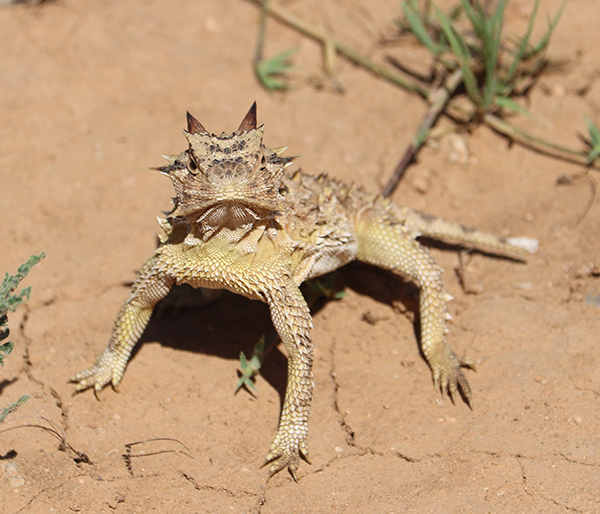
THIS FIERCE LOOKING little three or four-inch critter is not dangerous and is doing us a favor by dining on harvester ants (red ants). But they are declining on the Texas landscape. About the worst thing they do is spit blood at you. At least they don’t cause your bleeding! If you see one, just take a picture of it and let it be. Life has become hazard enough for him. He’s on a lot of predators’ preferred grocery list. (Photo courtesy of TPWD wildlife biologist Nathan Rains)
by John Jefferson
My momma told me not to eat green apples before going to bed.
I didn’t. But still had a strange but realistic dream. Unlike the night I dreamed I interviewed Calvin, of the Calvin and Hobbes comic strip, but it was certainly detailed. I searched the Internet for a TPWD press release on the toads/lizards for quite a while.
Finally, giving up, I called the TPWD Wildlife Information number and asked if there was a program to breed Texas Horned Lizards – AKA Horny Toads – and offer them to interested ranches. I think the lady thought at first, I was playing with her, but then figured if I had worked for TPWD once, that I might be weirdly serious.
She had me on hold for some time. I figured she was asking biologists about the horny toad program. Now I wonder if she was calling her supervisor. Or security. At any rate, she came back and apologized that she had been unable to find anything except something about a Houston toad.
That wasn’t it.
Then I went to the reptile biologist. Horny toads — believe it or not — are reptiles.
I’ve called him for strange wildlife questions before. I’m not sure whether that had anything to do with it, but I didn’t hear from him for over a week. After my second call to him, I finally heard from a field biologist he had referred my call to.
Nathan Rains assured me there was no such program. He said TPWD had studied Texas Horned Lizards for 15 years in hopes of saving the little guys from extinction.
Once profuse in Texas, they have become disturbingly rare. As a kid, I played with some of the scary looking but harmless little critters.
Didn’t everybody? Well, maybe not girls. They played with dolls and with nothing that boys liked.
Horny toads are said to be found in semi-arid habitats with sparse cover. Most of the ones we used to find were north of Beaumont in sandy soil. They range from Texas to Oklahoma, Kansas, and northern Mexico. Their favorite food is harvester ants (red ants). There are several commercial foods available on the Internet for pet owners.
At any rate, horny toads were about as common as armadillos. We saw them regularly. Then sometime around 20 years ago, I realized I hadn’t seen one in a while. Friends told me they hadn’t either. The last one I saw was during a dove hunt 25 years ago near Brownwood. In case you’re wondering — No, we didn’t shoot it! Except with my Nikon.
They’ve been placed on the Threatened List, and Rains says TPWD is working with zoos in Dallas, Fort Worth, Tyler, and San Antonio in captive breeding programs. TPWD is also studying some on the Mason Mountain Wildlife Management Area. They don’t bite and are not poisonous. The worst thing they do is spit blood at you with their eyelids.
That’s a rude way of saying, “Here’s looking at ya, Kid.”
JJ




